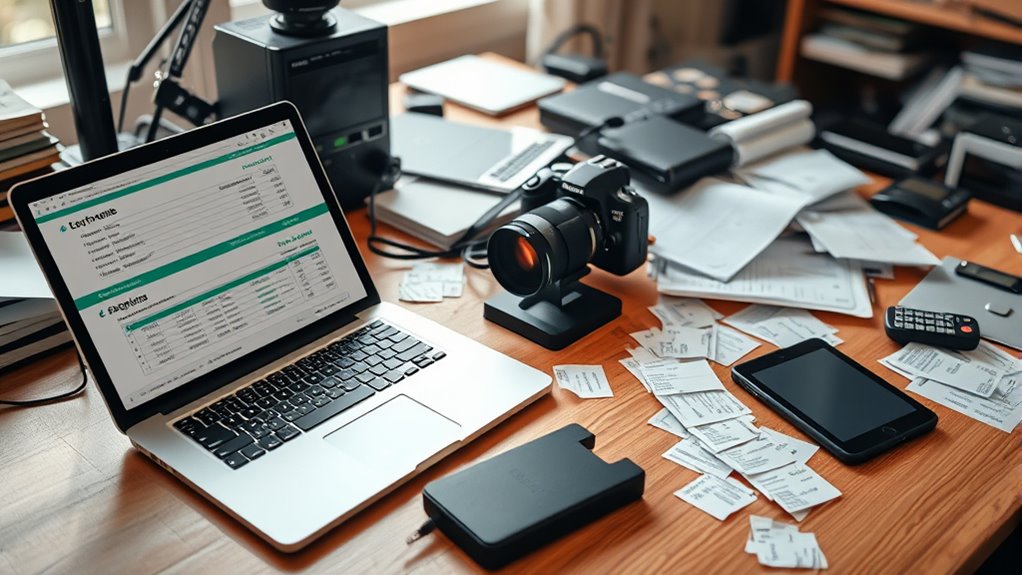As a freelancer, you can deduct the costs of software subscriptions and equipment purchases to lower your taxable income. Outright software buys are usually deductible in the year you purchase them, while ongoing subscriptions are deductible annually. For equipment, keep detailed records of purchase dates and costs, and determine if you should deduct immediately or depreciate over time. Proper record-keeping guarantees you maximize your deductions—continue exploring for more tips on organizing and optimizing these expenses.
Key Takeaways
- Keep detailed records of all equipment and software purchases, including receipts and purchase dates.
- Deduct outright software purchases in the year of purchase; treat subscriptions as ongoing expenses deductible annually.
- Determine if equipment should be depreciated over time or deducted immediately, based on cost and IRS guidelines.
- Organize documentation in dedicated folders or spreadsheets to simplify tracking and ensure compliance.
- Consult tax professionals or software to maximize deductions and ensure proper categorization of expenses.

If you buy software outright, you might be able to deduct the entire cost in the year of purchase. However, if you subscribe to software services, such as project management tools or design platforms, these are typically considered ongoing expenses. You can usually deduct software subscription costs in the year you pay for them, which makes them straightforward to track. Be sure to keep receipts or bank statements showing the recurring payments. Additionally, understanding the different types of fridge models can help you choose the most energy-efficient options for your business or personal use, potentially reducing ongoing costs. Tracking depreciation can seem complicated at first, but staying organized makes the process easier. Create a dedicated folder or spreadsheet for your equipment and software purchases, including the purchase date, cost, and how you use each item. This record-keeping will help you determine whether to depreciate an asset or deduct a subscription cost directly. Also, consult your tax software or a tax professional to confirm you’re applying the correct depreciation methods and maximizing your deductions.
Frequently Asked Questions
Can I Deduct Personal Equipment Used Partly for Work?
Yes, you can deduct the business portion of personal equipment used partly for work. For mixed use assets, you need to determine the percentage of time or use that’s dedicated to your work activities. Keep detailed records of how often and in what way you use the equipment for business. This way, you can accurately claim the deductible amount while ensuring compliance with tax regulations.
How Do I Handle Software Subscriptions That Cover Multiple Years?
You should spread the cost of multi-year subscriptions and software licenses over their useful life. For example, if you pay for a multi-year subscription, divide the total cost by the number of years it covers. Each year, deduct the portion applicable for that year as an expense. Keep records of payments and the subscription period to accurately allocate deductions and guarantee compliance with tax rules.
Are There Limits on the Amount I Can Deduct Annually?
You might think there’s no limit to your deductions, but expense caps and deduction limits do apply. The IRS typically allows you to deduct the full cost of equipment and software up to certain thresholds, often $2,500, with larger expenses needing to be capitalized and depreciated over time. Always check current IRS rules, as these limits can change, and keep detailed records to substantiate your deductions.
What Documentation Is Needed to Support My Equipment Deductions?
To support your equipment deductions, you should keep receipts and invoices for all purchases, ensuring they detail the items and costs. Additionally, maintain maintenance records to prove ongoing expenses related to your equipment. These documents serve as proof if you’re ever audited, helping verify your deductions. Organize digital or physical copies of these records, and update them regularly to keep your documentation current and exhaustive.
Can I Deduct Expenses for Upgrading or Repairing Equipment?
Upgrading or repairing your equipment can be deducted, but it depends on the situation. If the repair simply restores your equipment to its original condition, you deduct it as an expense. However, if the upgrade or repair results in a capital improvement or leasehold improvement, it’s considered a capital expenditure, and you may need to depreciate it over time rather than deducting it all at once. Always keep detailed records to support your claims.
Conclusion
Remember, keeping track of your equipment and software expenses isn’t just good practice—sometimes, it feels like the universe aligns to help you save when you least expect it. By staying organized and aware of what you can deduct, you might find yourself surprised by a little extra in your pocket at tax time. So, stay diligent, and who knows? That overlooked software purchase or new gadget could be your next big deduction, just when you need it most.








